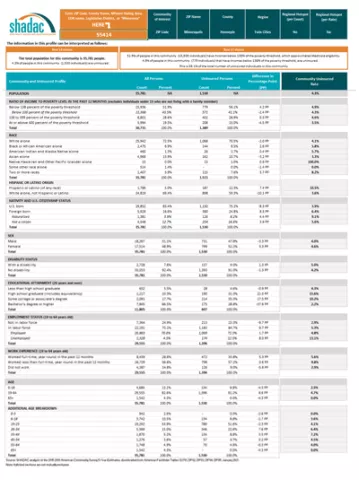All of the original features of the Minnesota Uninsured Profile Tool— the ability to compare characteristics of the total population to the uninsured population by state, region, county, economic development region (EDR), MNSure rating area, and specific ZIP code, as well as an in-depth profile of community characteristics—have remained as part of the resource since its first release; however, an update in the fall of 2020 added the ability to sort and view the uninsured population by state legislative district (both House and Senate), and this latest update pulls estimates from the U.S. Census Bureau’s American Community Survey (ACS) to populate the profile with the latest available data from 2019.
Recent studies have suggested that many Minnesotans, along with workers and dependents across the rest of the nation, have suffered pandemic-related coverage losses such as from employer-sponsored insurance, and may be unaware of possible options for new coverage.1 Tools such as the Minnesota Uninsured Profile, then, may offer some assistance in outreach efforts for both the historically uninsured as well as those newly uninsured.
Three other accompanying resources have also been developed alongside the profile tool: The first; an infographic series featuring color-coded state legislative district maps categorized by four levels of need for coverage assistance: Needs Most Assistance; Needs Significant Assistance; Needs Some Assistance; and Needs Less Assistance; with detailed socioeconomic data about that respective district's uninsured population, such as race, ethnicity, income, and age. The second is a brand-new video tutorial, narrated by profile development team member and SHADAC PhD student Cynthia Pando, offering a step-by-step walkthrough of how to access the uninsured profile, and how to use the downloadable data spreadsheet.
Information presented in the profile tool is also supplemented by the third resource, an interactive map that shows users the geographic makeup of each ZIP code in relation to schools, hospitals, native reservations, and other important or distinctive landmarks.
Continuing to make timely and relevant updates has always been a goal of the project, according to Principal Investigator Dr. Kathleen Call, who noted that her team is working “to meet the changing needs of navigators and other data users” by making changes to the profile that will “matter most in the decisions they are making to learn more about their communities and those who lack health insurance coverage.”
For additional information on the uninsured profile tool, or to request the development of a similar tool for another state, users can access the Uninsured Profile Resource Page on SHADAC’s website where the tool is available for download in Excel spreadsheet format, the interactive map can be accessed, and an option to provide Dr. Call with feedback on their user experience is located.
1 Planalp, C. (2021, March 1). Minnesota’s coverage dynamics shifted prior to pandemic. State Health Access Data Assistance Center (SHADAC) Blog. https://www.shadac.org/news/minnesotas-coverage-dynamics-shifted-prior-pandemic
Golberstein, E., Abraham, J.M., Blewett, L.A., Fried, B., Hest, R., & Lukanen, E. (2020). Estimates of the Impact of COVID-19 on Disruptions and Potential Loss of Employer-sponsored Health Insurance (ESI). State Health Access Data Assistance Center (SHADAC). https://shadac-pdf-files.s3.us-east-2.amazonaws.com/s3fs-public/publications/UMN%20COVID-19%20ESI%20loss%20Brief_April%202020.pdf

